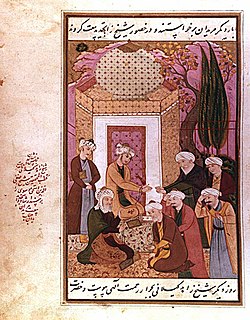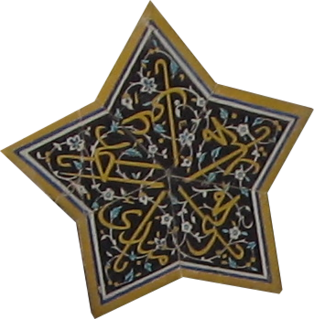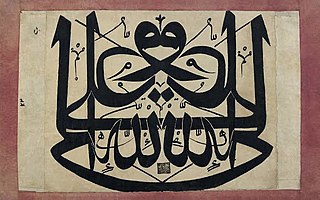Year 1301 (MCCCI) was a common year starting on Sunday of the Julian calendar.

Taj Al-Din Ebrahim ibn Rushan Amir Al-Kurdi Al-Sanjani , titled Sheikh Zahed Gilani, was an Iranian Grandmaster of the famed Zahediyeh Sufi order at Lahijan. He is also known as Sultân-ûl Khalwatiyya and Tadj’ad-Dīn Ebraheem Zāheed al-Geylānī as well.

The Safavid order, also called the Safaviyya, was a tariqa founded by the Kurdish mystic Safi-ad-din Ardabili (1252–1334). It held a prominent place in the society and politics of northwestern Iran in the fourteenth and fifteenth centuries, but today it is best known for having given rise to the Safavid dynasty. While initially founded under the Shafi'i school of Sunni Islam, later adoptions of Shi'i concepts such as the notion of the Imamate by the children and grandchildren of Safi-ad-din Ardabili resulted in the order ultimately becoming associated with Twelverism.

Safi-ad-din Ardabili was a poet, mystic, teacher and Sufi master. He was the son-in-law and spiritual heir of the Sufi master Zahed Gilani, whose order—the Zahediyeh—he reformed and renamed the Safaviyya, which he led from 1301 to 1334.
Zahedi or Zahidi may refer to:
The Silsilat-al-nasab-i Safaviya, also spelled Selselat an-Nasab-e Safaviyye was written by Sheikh Pir Husayn 'Abd az-Zahidi, a 17th-century descendant of Sheikh Zahed Gilani, during the reign of Shah Sulayman. This hagiography, in praise of the Safavid forebearers, was devoted to the genealogy of Safavid Sufi masters.

Celvetîyye Tariqat or Jelveti is a Sufi order that was founded by "Akbıyık Sultan", a murid of Haji Bayram Veli in Bursa as "The tariqat of Bayramiyye-î Celvetîyye" and later reorganized by the Turkish saint Aziz Mahmud Hudayi. It shares the same spiritual chain as the Khalwati order and thus there are many similarities between them. The two orders split however with Sheikh Zahed Gilani, where the Jelveti order then goes on to Hajji Bayram and Aziz Mahmud Hudayi. Aziz Mahmud Hudayi was among the most famous of all Ottoman Sufi's being the Sheikh of Sultan Ahmed I who constructed the famous Blue Mosque. Aziz Mahmud Hudayi read the first Friday prayer in this mosque on its opening.
A list of topics related to the topic of Sufism.

The Qadiriyya are members of the Sunni Qadiri tariqa. The tariqa got its name from Abdul Qadir Gilani, who was a Hanbali scholar from Gilan, Iran. The order relies strongly upon adherence to the fundamentals of Sunni Islamic law.
Gilani or Gillani is a toponymic surname (nisba) linked to the Gilan Province in Iran. It is also used by people indicating association with the founder of the Qadiriyya Sufi order Abdul Qadir Gilani. Notable people with the surname include:
The Safvat as-safa, also spelled Safvat al-safa or Safwat al-safa, is a hagiography of the Sufi shaykh Safi-ad-din Ardabili (1252–1334), founder of the Safaviya Sufi order.
Nationality words link to articles with information on the nation's poetry or literature.
Sadr al-Din Musa(1305-1391)(صدر الدين) was the son and successor of Safi-ad-din Ardabili. His mother was Bibi Fatima, daughter of Zahed Gilani. Sadr al-Din directed the Safaviyya for 59 years. During this time, the activities of the Safaviyya were viewed with favour by Timur, who provided an endowment for the shrine of Safi-ad-din Ardabili in Ardabil, and allowed Sadr al-Din to collect taxes. Timur also offered Sadr al-Din to request any favour from himself, and Sheikh Sadr al-Din asked for the release of Turkish prisoners captured by Timur from Diyarbakır. Timur accepted this request, and the freed prisoners became Sadr al-Din's loyal disciples. The descendants of these freed prisoners, emigrating by the thousands into Gilan Province, would later aid his family to found a dynasty.
Zahed (Zahid) is an Arabic, Iranian, and Indian male name that means ascetic. Notable people with the name include:
Akhsitan III was the 29th ruler of Shirvan, now part of Azerbaijan. He was the son of Shirvanshah Farrukhzad II.

The Mausoleum of Abdul-Qadir Gilani, also known as Al-Ḥaḍrat Al-Qādiriyyah or Mazār Ghous, is an Islamic religious complex dedicated to Abdul Qadir Gilani, the founder of the Qadiriyya Sufi order, located in Baghdad, Iraq. Its surrounding square is named Kilani Square. The complex consists of the mosque, mausoleum, and the library known as Qadiriyya Library, which houses rare old works related to Islamic Studies. The son of the entombed scholar, Abdul Razzaq Gilani, is also buried there.







